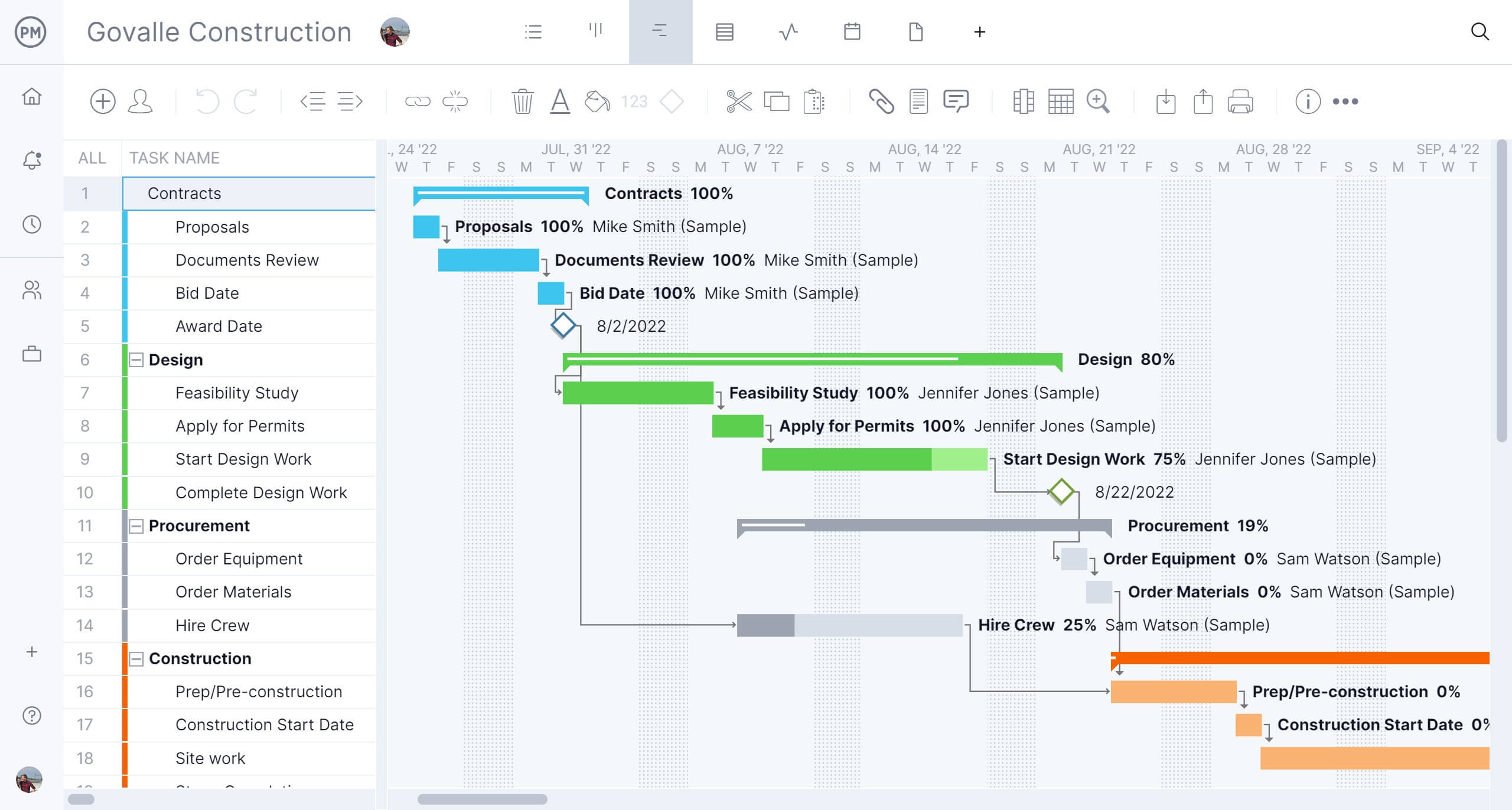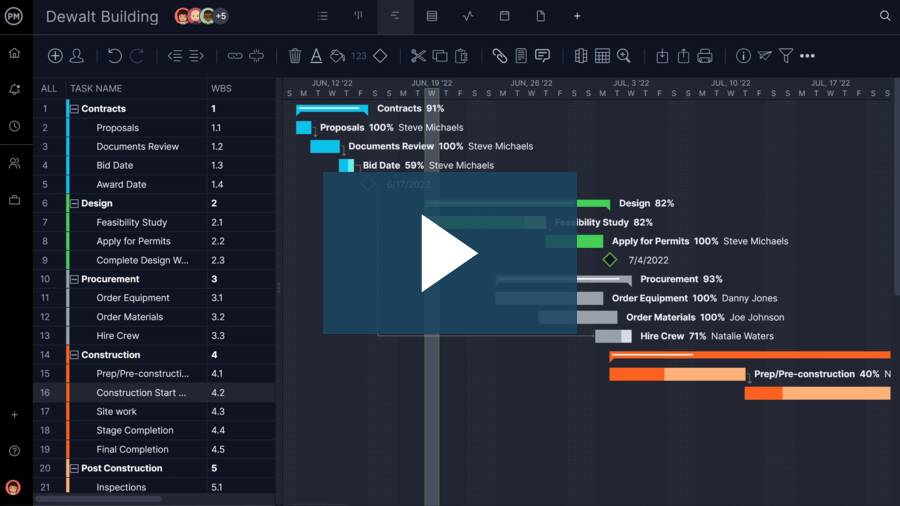- What Is a Construction Plan?
- What Is Construction Planning?
- What Should Be Included in a Construction Plan?
- Construction Project Planning Steps
- Who Makes the Construction Plan?
- What Is Construction Planning Software?
- Construction Plan Example
- Must-Have Construction Planning Software Features
- How to Make a Construction Plan with ProjectManager
- Construction Planning Tips
- Maintain Your Construction Project Plan
- Construction Planning: Glossary of Terms
What Is a Construction Plan?
A construction plan is a set of documents that defines the requirements for a construction project, such as the activities, resources, schedule and budget. A construction plan is created during the construction planning process and includes the following:
- A written document that defines the methodologies and approach
- Blueprints, computer-aided designs, photographs, and other images that illustrate the design
- A work breakdown structure that identifies all the activities that make up the project
- A construction project schedule that organizes all the project activities on a timeline
- The construction project participants and stakeholders such as contractors, sponsors, crews, etc.
Creating a construction plan is of crucial importance in construction management, given that such projects tend to be large and complex. Proper and thorough construction planning greatly increases the likelihood of a successful project.
The more information the construction plan has about your project, the less likely it will be that issues arise during the execution phase. Before the ground is broken your construction plan (and your construction schedule) should be as solid as a rock.
Construction project management software that’s complete with online Gantt charts can help you guarantee that all that robust construction planning won’t go to waste when it comes to the execution phase.

ProjectManager’s online Gantt charts make construction plans come to life.
What Is Construction Planning?
The term construction planning refers to a series of activities that need to be completed to make a construction plan and prepare a job site for the construction of a building, such as gathering requirements and specifications from the project owner, procuring resources, obtaining permits from the local government, among many other things.
These activities might change depending on the size and complexity of projects, or the specific procedures and guidelines of an organization, however the main activities of the construction planning phase include defining the project’s scope including its objectives, deliverables and boundaries, creating a construction schedule, making a construction budget, allocating resources and making a risk management plan.

Get your free
Construction Schedule Template
Use this free Construction Schedule Template to manage your projects better.
Get the templateWhat Should Be Included in a Construction Plan?
To make a construction plan, you need to identify all the different aspects of your project including the project management team, stakeholders, activities, resources requirements, scheduling and budget.
- Project Overview: What are the purpose and objectives of the construction project? Who are the stakeholders? How are you planning to execute it? What is the return on investment of the project?
- Scope of Work: The scope of work of a construction project describes in detail the work that will be executed so that stakeholders know what to expect in terms of deliverables and milestones. It also explains what activities won’t be included in the project.
- Resource Requirements: Allocate resources for each activity. What materials and equipment will be needed? What are the labor requirements?
- Construction Schedule: Now that you know the activities and resources needed for your project, you need to create a schedule to procure the resources and execute the activities.
- Construction Budget: The construction budget should account for all project costs including labor, materials, equipment, subcontractor and contingency costs.
- Architectural Drawings: These are detailed drawings that communicate detailed information about the building, and they play an important role in planning, design and construction. They may include floor plans, site plans, elevations, 3D models and more.
- Visual Plans and Renderings: These are construction specifications, project renderings and other drawings that can be shared with stakeholders, local officials, etc.
- Construction Specifications: A construction specifications document outlines the project’s needed materials, workmanship and quality standards. It offers precise technical descriptions, performance criteria and compliance standards.
- Procurement Plan: This is a strategy for getting the needed materials, equipment and services for the project. The procurement plan involves delivery schedules, procurement methods and cost control measures.
- Quality Assurance & Control Plan: A framework for maintaining and confirming the quality of work and materials during construction. This could include inspection schedules, quality benchmarks and testing protocols and procedures.
- Change Management Plan: A construction project plan also has a change management plan to document changes to the project’s scope, schedule or budget. It has a plan for how changes are requested, reviewed, approved and implemented.
- Construction Site Plan: The site plan is a detailed map or diagram of the construction site that shows the layout and placement of things like worker facilities, material storage areas, access routes and structures under construction.
- Construction Safety Plan: This document outlines the safety measures, protocols and procedures to ensure that workers, site visitors and the general public stay safe during the construction process.
- Construction Logistics Plan: The logistics plan outlines the organization and coordination of resources, equipment, materials and workforce to ensure site operations are efficient. It includes delivery schedules, storage areas, equipment placement and overall site workflow.
- Construction Traffic Management Plan: This part of the construction project plan outlines the strategy for managing vehicle and pedestrian traffic around and within the site. This helps prioritize safety and ensure disruptions are limited.
- Construction Waste Management Plan: How will waste generated during the project be disposed of? The waste management plan notes how it will be handled, minimized, reused, recycled or disposed of.
- Communication Plan: To effectively implement various aspects of your project plan, you must articulate them clearly and communicate effectively with stakeholders. A communication plan allows you to define your communication goals and objectives, then decide on what methods you’ll use to deliver them.
- Risk Management Plan: All projects have risks, but construction projects have risks on a different level, which is why it’s so important to make a risk management plan. You’re going to have to provide safety management, which will include a thorough assessment of what might go wrong and how you resolve it.
- Construction Team: Define Who is leading the project, and who will make up the teams executing the plan? Who are the contractors? The size of the construction project will determine, to some extent, how many people are working on the project team.
Construction Project Planning Steps
While making the construction plan is the most important outcome of the construction planning process, other activities must be completed before making one.
1. Meet with Stakeholders to Gather Requirements
Before construction project planning can be in full effect, there needs to be a meeting with stakeholders where requirements are gathered and expectations are understood. This is an essential step to ensure that the project manager and other relevant parties have a strong understanding of the ideal project goals and outcomes.
2. Conduct a Feasibility Study
Next, conduct a feasibility study, or a detailed assessment of the proposed project plan in terms of technicality, economics, finances, etc. This helps determine how practical the proposed project is and its potential for success. By the end of the feasibility study, it should be clear whether or not to move forward with the project.
3. Perform a Site Analysis
During this step of the construction management plan, various factors will ensure that the site of the project is thoroughly examined. It helps minimize potential problems by looking at site characteristics, access, environmental considerations, constraints and safety.
4. Define the Project Scope with a Work Breakdown Structure
Use a work breakdown structure to visualize your project scope and define all the activities needed to produce the deliverables and reach the milestones of your construction project.
5. Conduct a Material Takeoff
A material takeoff consists in itemizing every construction material that will be needed. This is done by using measurement scales of length, area and volume.
6. Make a Bill of Quantities
A bill of quantities is a construction document that explains the type of materials, units of measurements, quantity and labor that will be needed to build a construction project.
We’ve created a free bill of quantities template for Excel to help with this process.
7. Request Vendor Quotes
Submit a request for quote to material and equipment suppliers to get up-to-date pricing information on materials such as wood, concrete, masonry and other types of project resources so that costs can be estimated accurately.
8. Estimate Costs of Materials and Labor
Once you’ve defined your material takeoff and bill of quantities, you can prepare a construction estimate. This is done by assigning costs to the itemized construction materials that were previously identified in the Material takeoff (MTO). Then, to create a budget, add all the construction costs. This includes materials, labor, equipment and contingency costs.
9. Hire a General Contractor or Subcontractors
A general contractor can help oversee the project and coordinate any work with various subcontractors such as plumbers, electricians or carpenters. Having a general contractor on the project can help guarantee a smooth workflow and reduce the risk of delays.
10. Finalize Contracts with Vendors and Contractors
At this point, be sure to finalize any outstanding contractors with vendors or contractors. Both parties should review the contracts thoroughly, negotiating if needed. Once both parties sign the final contract, it becomes legally binding.
11. Set up Job Site Facilities
Before the construction project management plan moves forward, be sure to set up job site facilities such as restrooms, first aid stations, storage areas, break rooms, site offices, handwashing stations, etc.
12. Obtain Building Permits
Before work can begin, it is required that you obtain a building permit. A building permit is issued by the local building department of the municipality and authorizes the construction team to move forward with the project. Typically, a separate permit is required for each type of work (demolition, plumbing, electrical, mechanical work, etc.).
Who Makes the Construction Plan?
The project manager is usually the person tasked with making the construction plan. However, the creation of a construction plan isn’t done in isolation. Stakeholders need to be included to understand and manage their expectations, and construction crews must be consulted as well to get insights from their skills and experiences in similar jobs.
Because a construction project involves a lot of different phases and teams, it’s important that they’re all part of the construction planning process. For example, estimators will need the project plan to guide them in procuring materials. Also, the various perspectives will improve the viability of the final construction project plan.
What Is Construction Planning Software?
The use of dynamic construction planning software is essential to delivering the project on time and within budget.
Construction planning software organizes the tasks of a construction project plan and integrates the construction schedule with features that help with administrative tasks, estimating, resource management, time tracking and more.
Using online construction scheduling software gives managers real-time data to make better decisions and gives construction crews a collaborative platform to work more productively. Live data also assists in managing the project workload to keep teams’ tasks balanced. Additional benefits include:
- Creating a detailed roadmap with activity dependencies and milestones
- Making assignments, attach CAD, plus other files and images
- Monitoring and controlling performance, productivity, progress, costs, resources and more
- Connecting teams in real-time for better collaboration
- Sharing plans, status and other reports with teams and stakeholders
- Live data for better decision making
- Controlling costs and tracking team’s logged hours
Construction projects have lots of requirements, regulations, blueprints, drawings, punchlists and other paperwork, and construction planning software acts as a central hub for collecting important documents and images to make them easily accessible. Microsoft Project is one of the most commonly used project management software, but it has major drawbacks that make ProjectManager a better alternative for construction projects.
Construction Plan Example
The best way to understand how to make a construction plan with construction planning software is to use ProjectManager’s construction plan template. With it, you can practice adding tasks, construction phases, dependencies, resource costs and more in a live Gantt environment.
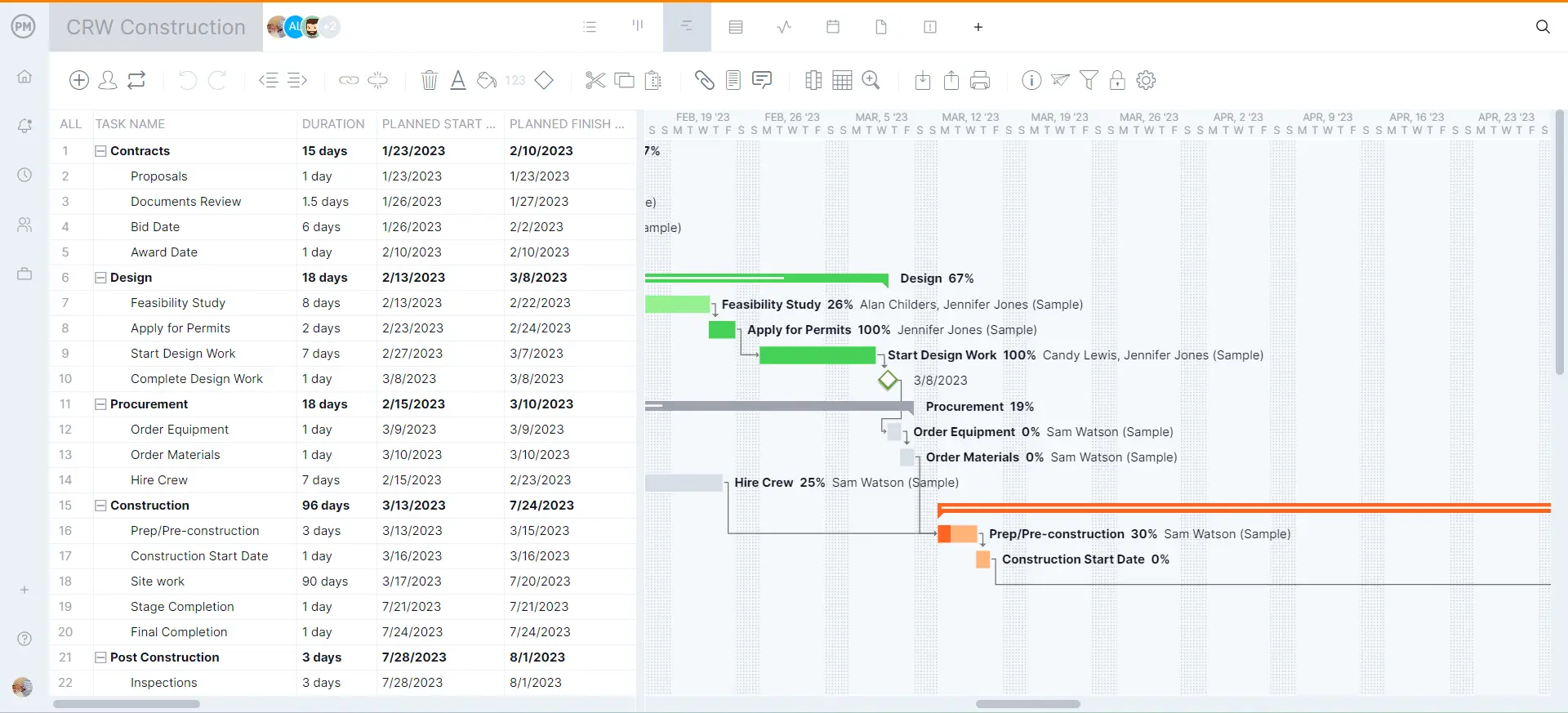
On the left-hand side the various phases of the construction project are outlined. These can be color-coded to make it easier to distinguish one phase from another. Under each phase are the tasks associated with it, including assignees, due dates and other resources needed to deliver the construction project on time.
The visual timeline to the right is where things get interesting. You can see the entire project in one place, dependent tasks can be linked and milestones added to indicate important dates. Plus, you can easily print out the Gantt and bring your construction plan with you to the job site for reference.
Must-Have Construction Planning Software Features
Cloud-Based for Real Data
Get real-time updates to your construction project schedule and know how tasks are progressing, even when you’re off-site. Save time by providing on-site workers timely updates, without emails and calls. Monitor and track progress and performance as it happens.
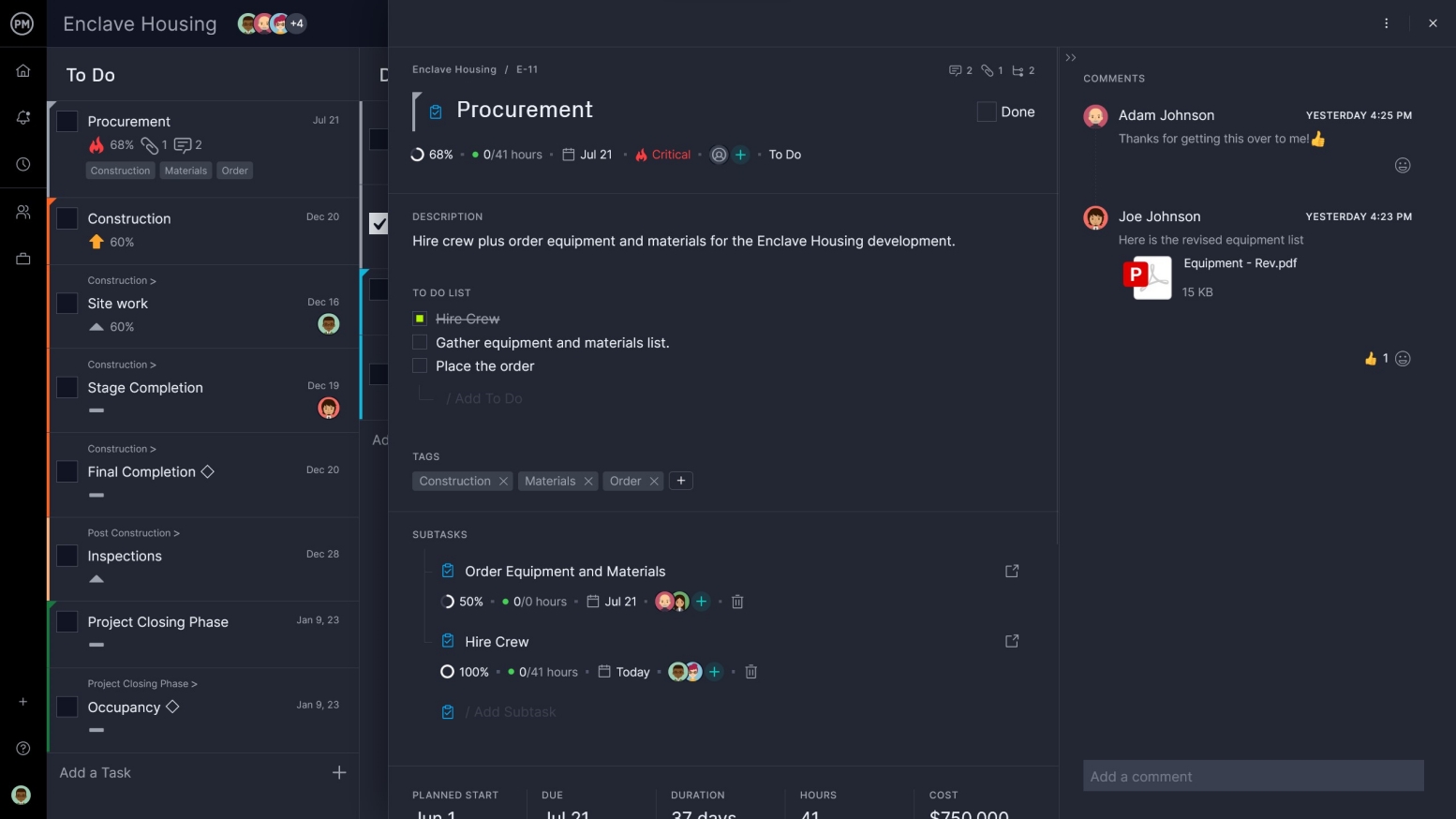
Online Gantt Charts for Dynamic Planning
Plan and schedule work and keep your team working together. Share your construction plan with your crew, contractors and stakeholders. Link dependencies to avoid bottlenecks, break the project into phases with milestones and assign your workers and subcontractors.

Task Management Keeps Crews Working
Drive progress on-site by assigning and tracking tasks anywhere and at any time. Give your team a collaborative platform to share files and work better together. Easy onboarding, personal task list and you can filter tasks to see just what you need to know.
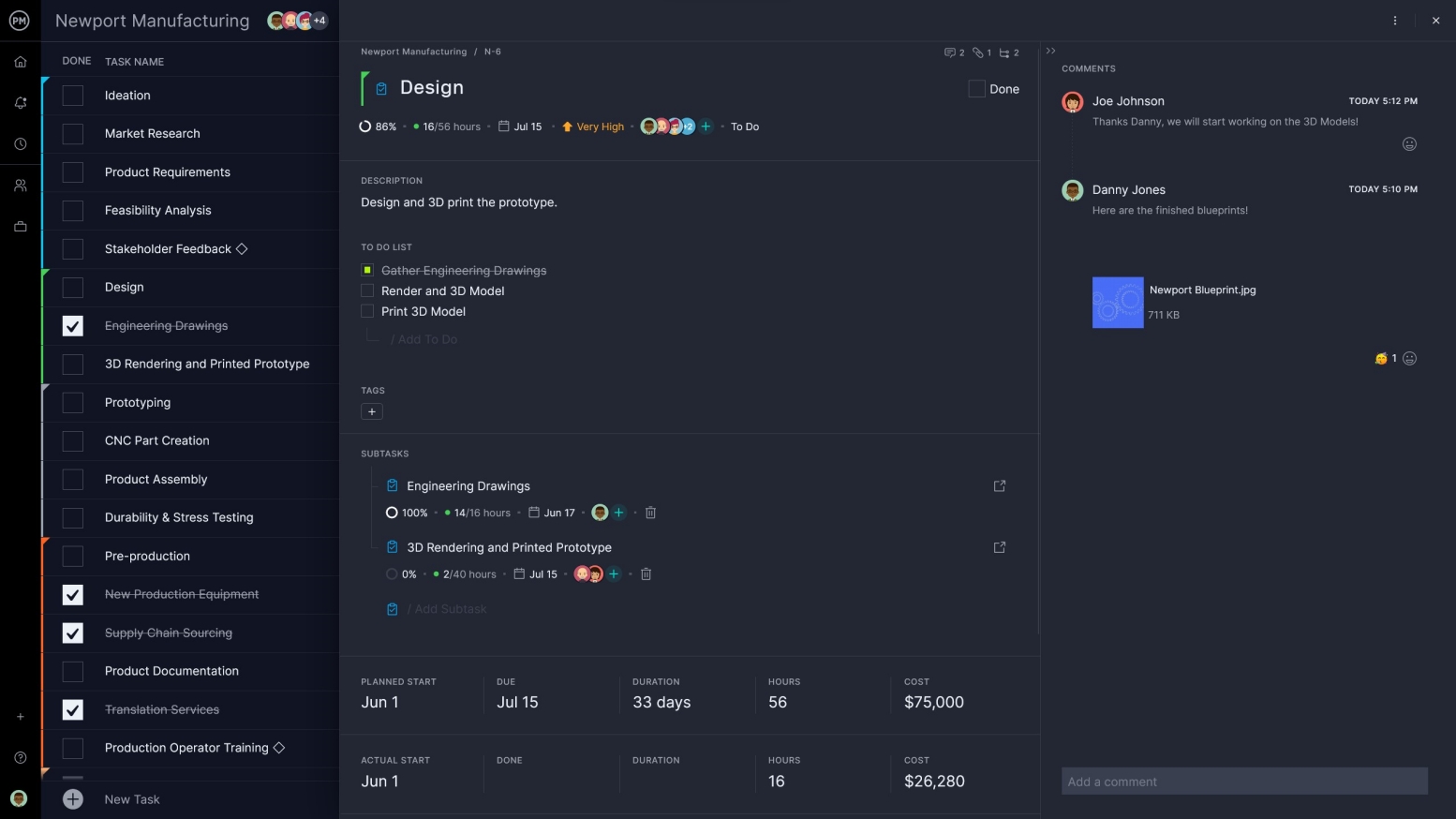
Workload View for Resources
Plan your resources and associated costs to execute the tasks in your construction plan. Track the availability of your resources to make assigning more efficient. A workload page shows the utilization rate of your crew and lets you reallocate their work to balance the workload.

Timesheets Track Logged Hours
Record and track the time your crew spends on their work with easy-to-use timesheets. Copy last week adds tasks and hours from the previous week and auto-fill will add the team member’s assigned work. Add comments, files and when submitted the timesheet is locked.
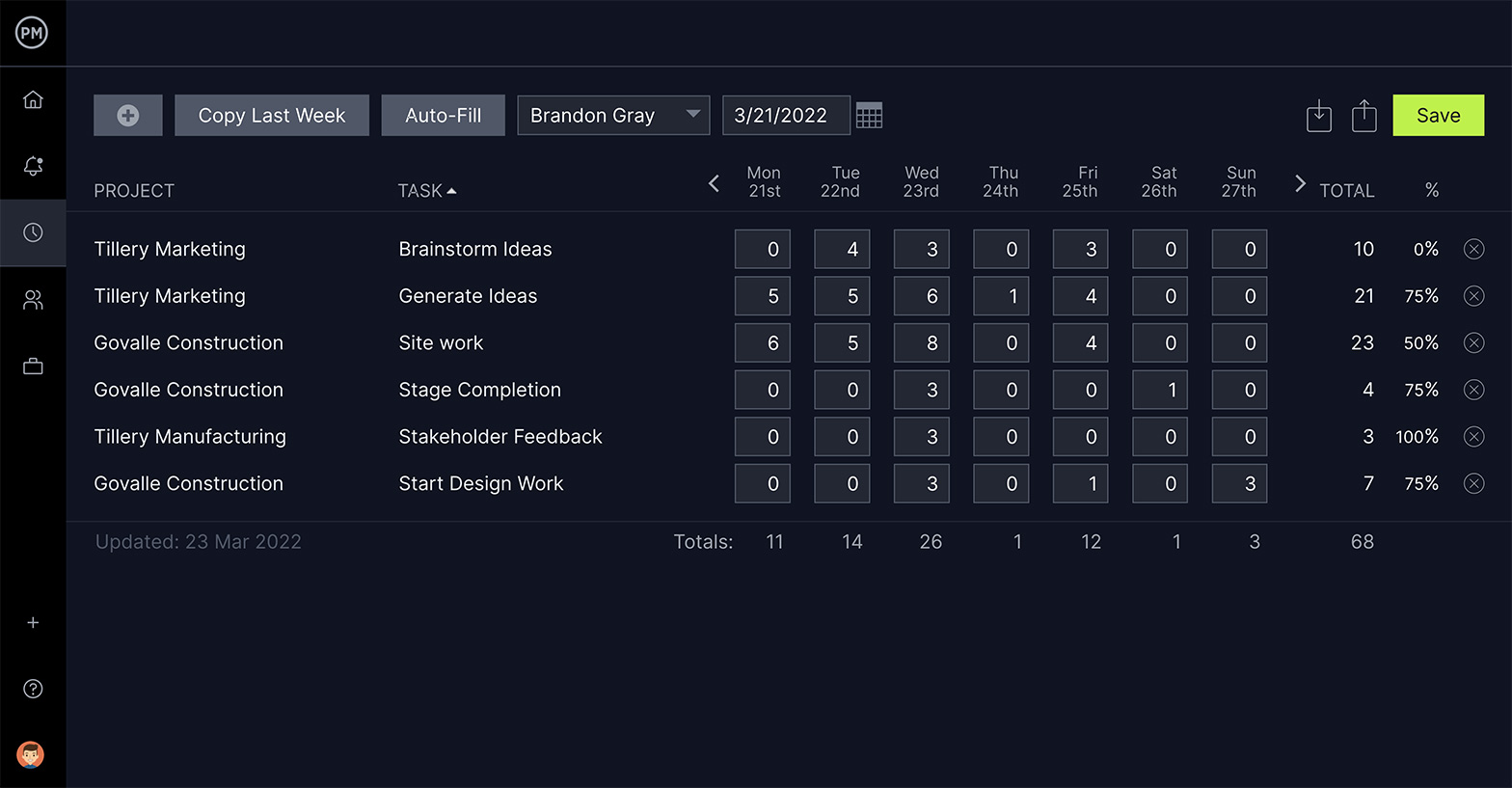
Dashboard & Reports Help Stay the Course
Collect, monitor and track construction data from a high-level with a real-time project dashboard. It does the calculations for your and then displays metrics such as cost, project variance and more in easy-to-read graphs and charts. Go deeper with one-click reports to keep track of costs, activities, time and more.

How to Make a Construction Plan with ProjectManager
ProjectManager is an award-winning construction plan tool that helps you organize all the components of your build, from initiation to close. Our cloud-based software has the feature you need to plan your project, manage your tasks and build a schedule that will meet your deadline and stay within your budget.
Start your next project off right by signing up for a free 30-day trial of our software and then follow these steps to build your construction plan.
1. Schedule Tasks
Organizing tasks is the first step in a construction plan. Some tasks that are dependent on others, such as painting can’t start until space is built to paint. Milestones mark important dates.

Import, manually input or use industry-specific templates to get your tasks in a Gantt. Add deadlines and they populate a timeline. Link dependencies to avoid bottlenecks and set milestones to show when one task ends and another begins.
2. Create Punch Lists
Creating a punch list is a simple to-do list to get your through the day. Having a more dynamic to-do list can help you manage that work and be more productive.
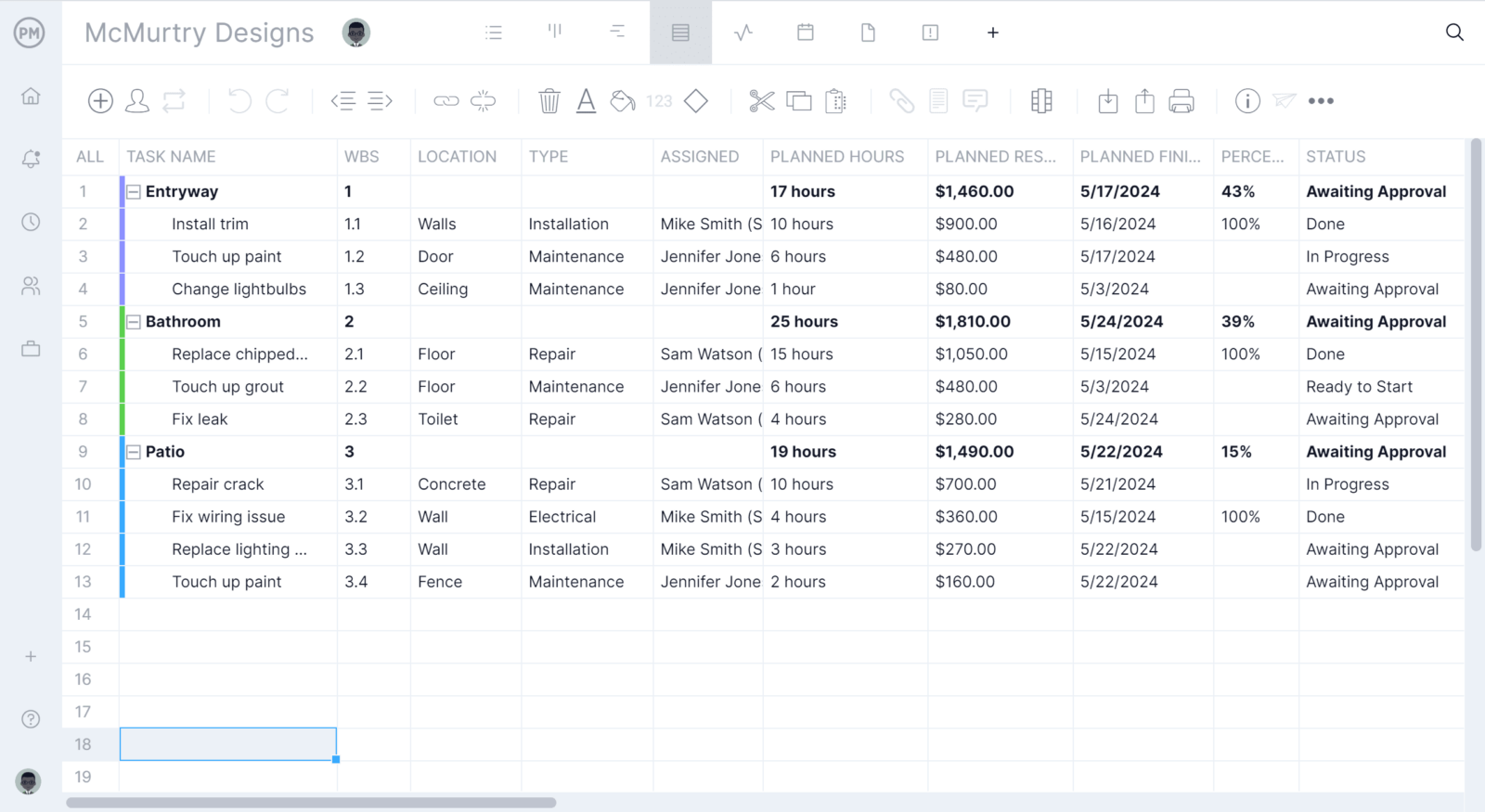
Use a task list to create a personal to-do list, tag them for priority and more. Set up notifications to keep you on schedule. Or use the kanban board to visualize the workflow.
3. Balance Workload
Keep teams productive by managing their workload to make sure no one person is carrying the bulk of the tasks on their back.
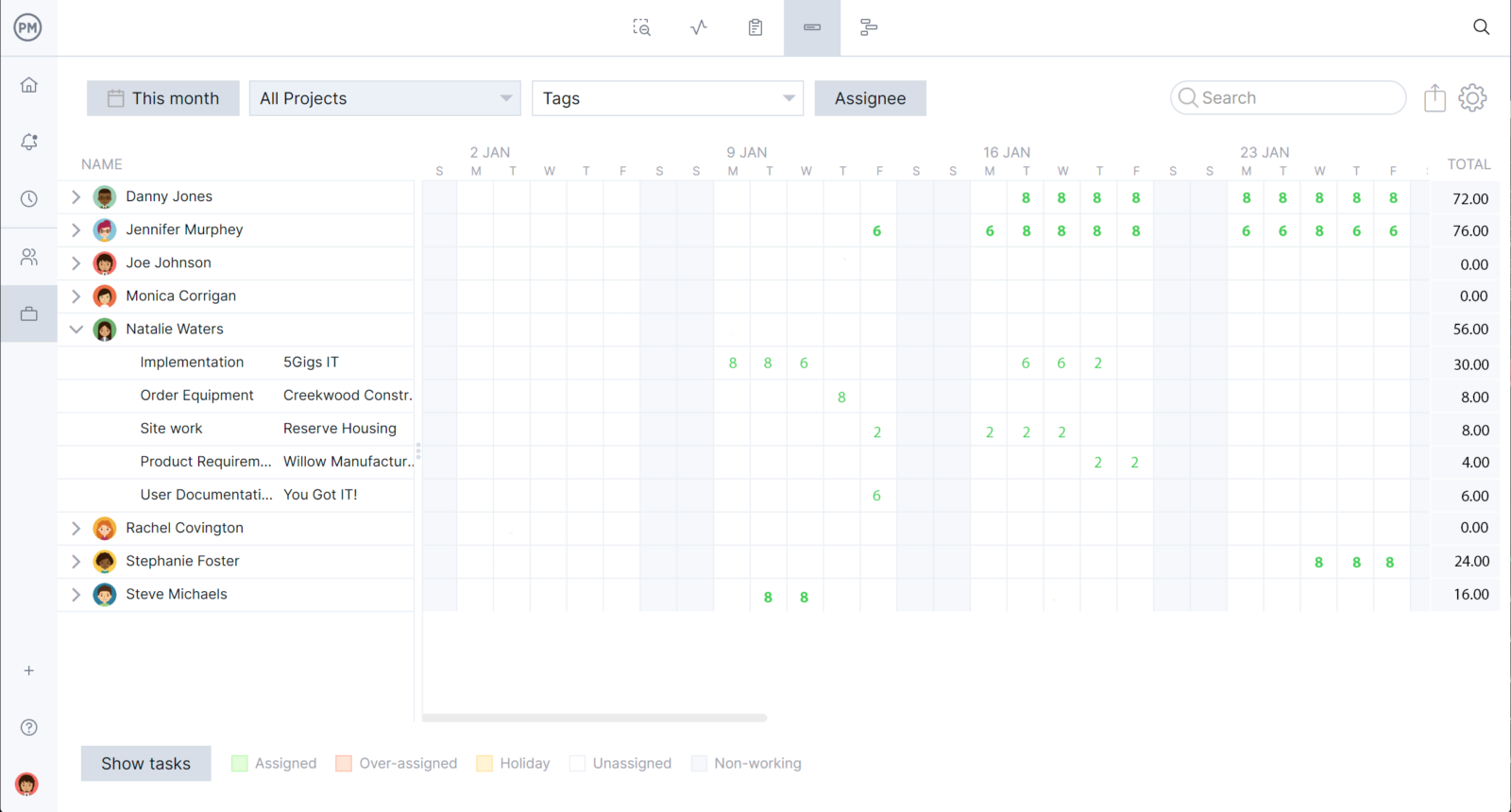
View the workload chart and see exactly how much work is assigned to each member of your team, whether they are in the field or in the back office. The color-coded calendar makes it easy to see who’s overallocated and allows you to reallocate their work right then and there.
4. Track Hours Logged
Knowing how many hours your crew has worked on their tasks is how you calculate payroll. It’s also another tool to measure your progress.
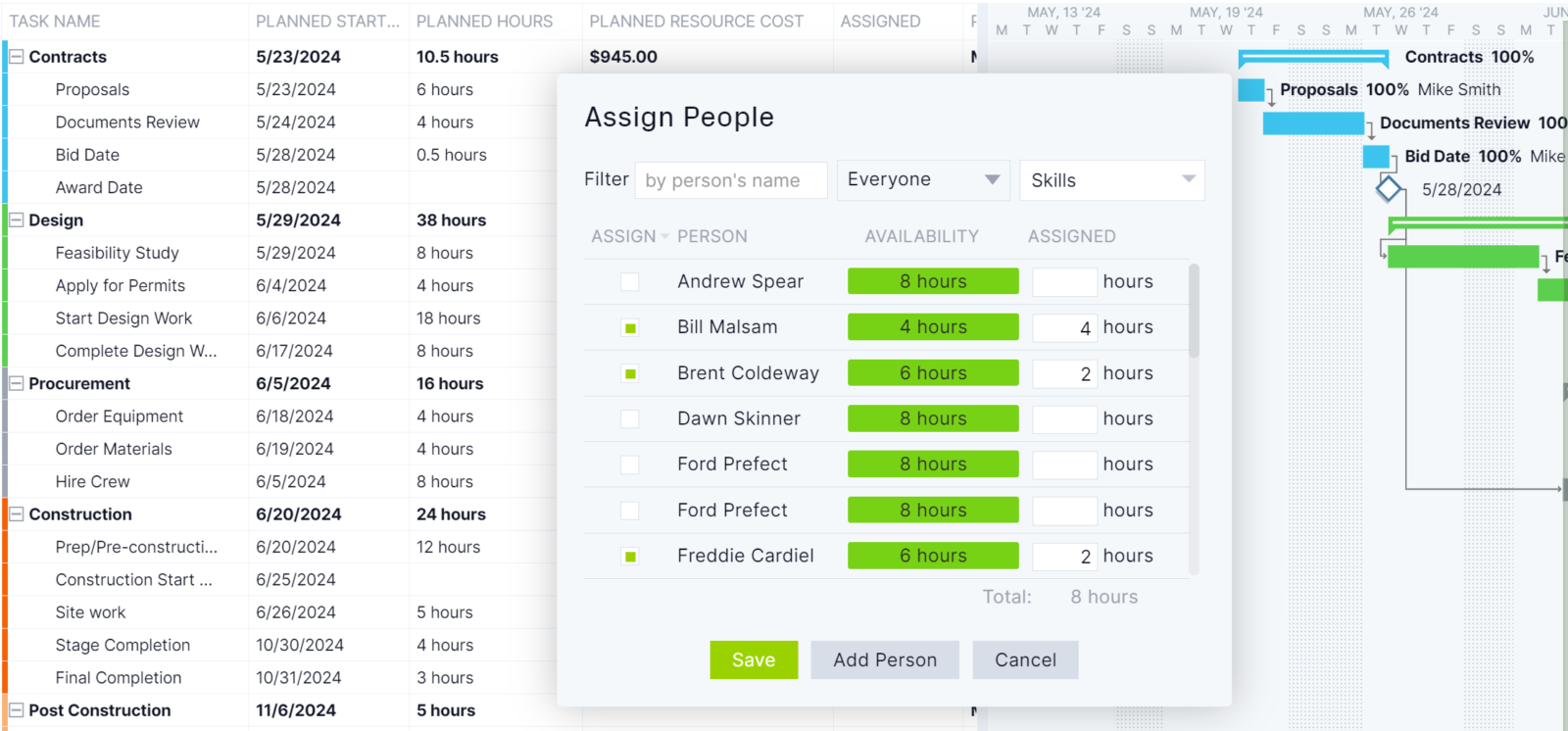
Submit timesheets securely online as your team completes their assigned tasks in your construction plan. Approve timesheets with just one click. Now you can have your timesheets and your planning tools together in one easy-to-use software.
5. Monitor and Report
Staying on schedule and keeping your stakeholders updates are two reasons why monitoring progress and performance are so important.
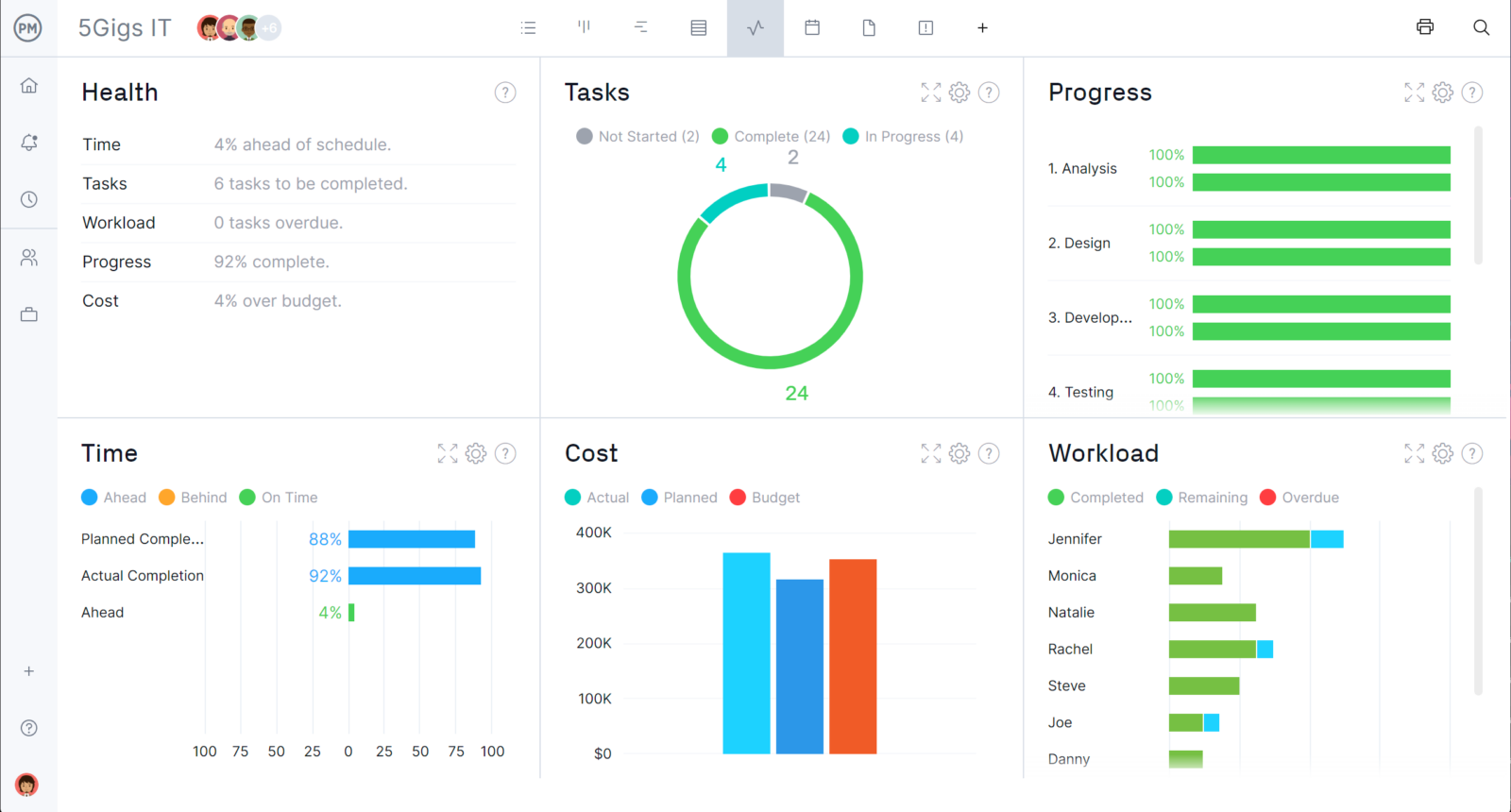
Get live data with real-time dashboards and make the critical decisions required from construction project managers. See task progress, workload, and more with one live view. Reports go deeper into the detail. They can be filtered and shared as a PDF or printed.
Construction Planning Tips
All construction plans have one thing in common—whether they’re for a commercial or residential build—and that is the desire to complete the job on time and within budget. Here are some construction planning tips to make sure you create the best possible construction plan.
1. Assemble the Right Team
Not every construction project is the same; therefore, the team you assemble to execute the project should have the experience and skillset to do the work properly. That includes the engineers, builders, contractors and anyone associated with an aspect of the build. Without the right team, a great plan is destined to fail.
2. Define “Complete”
It sounds obvious, but gather a dozen people and you’ll get two dozen answers on what “complete” means. To avoid this, you need to clearly outline the parameters of a completed task. This must also take into account the project timeline and budget, as well as the opinions of your stakeholders.
3. Keep the Lines of Communication Open
During the planning phase, you’ll want to hear from stakeholders, regulators and even team members to get a full picture of the project’s expectations and constraints. A plan is a way to communicate, but it’s not the only way. Plans change, and those changes need to be clear. Create a communication plan. Stay connected and keep records.
4. Be Aware of Risk
As noted above, change is part of any project. There are always internal and external forces at play that will impact your plan. Create a risk management plan to anticipate potential changes and how they’ll be managed. Include this to give yourself the wiggle room you’ll need to adjust according to unplanned changes.
5. Always Be Planning
The project plan must not only have tasks with slack in case of delays, it should come with an eraser. A construction project plan is not written in stone. It’s a living document, one you not only refer to throughout the life cycle of the project, but continuously adapt to the reality on the site.
How to Maintain Your Construction Project Plan
Making a construction project plan is only the beginning—you also need to maintain it! Here are some ways to manage your construction management plan.
Create a Roadmap
Construction projects must coordinate a variety of smaller projects to reach the final deliverable (digging the foundation, laying concrete, electrical and so forth.) Each of these phases has to work together to save time and money. Orchestrating that is complex, which is why a roadmap is essential. A roadmap is a visual tool like a Gantt chart; only it can show several projects together on a single timeline to help you work more efficiently.
Meet Regularly With Stakeholders
The stakeholder has a vested interest in the construction project. You share the plan with them, but that doesn’t mean they’re out of the picture until the project is complete. They might not want to go into great detail as you would with your team, however, a broad strokes approach to updates is crucial to manage their expectations. It’s likely that during the execution stage they will have change requests that will directly impact the plan. Figure out how and when to meet, as well as the frequency of those meetings.
Keep an Eye on Quality
The triple constraint helps you keep you plan on track by balancing cost, scope and time. But there’s a silent forth partner to this classic project management term, and that is quality. Getting the project built on time and within budget is important, but if that’s done at the expense of the integrity of the structure the project is a failure—and likely a lawsuit! To avoid these dire consequences, quality must be on the radar. To manage the quality of your project, your project plan must identify benchmarks and measure these throughout the execution of the construction project plan.
Construction Planning: Glossary of Terms
The following is a mini-glossary of construction planning terms that have been used in this guide.
- Assignable Square Footage (ASF): Usable footage from finished to finished wall
- Blueprint: Drawing detailing architectural design of building
- Building Information Modeling (BIM): Used to create computer model of building
- Computer-Aided Design (CAD): Architectural modeling software
- Cross Section: Shows what building would look like if vertically sliced to show layers
- CSI Master Format: System for organizing construction information
- Feasibility Study: A feasibility study determines project budget, schedule and requirements
- Group I Equipment: Structural building elements
- Group II Equipment: Movable elements, such as furnishings
- Gross Square Footage (GSF): Includes unusable space in the building
- Leadership in Energy and Environmental Design (LEED): Sustainable design
- Performance Specifications: Minimum acceptable standards
- Permits: Authorization from municipality required for construction
- Preliminary Design: Plan showing physical spaces of building
- Schematic Design: Conceptual plan of building
- Zoning: Government regulations restricting property use
Start your free 30-day trial
Deliver faster, collaborate better, innovate more effectively — without the high prices and months-long implementation and extensive training required by other products.
Start free trial